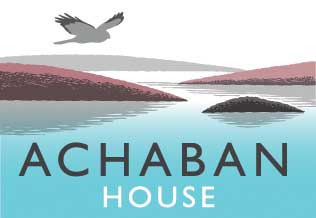


This walk to the local abandoned coastal quarry of Torr Mor is of particular historical interest to Achaban House, not only because it was built of the pink granite from the quarry. Neil MacCormick was quarry master from 1881 and lived in Achaban House until his death in 1929 . He had a distinctive career and the first of his 11 children, John, was a celebrated Gaelic scholar, writing the first ever Gaelic novel.
The distinctive pink-coloured Ross of Mull granite is thought to be about 400 million years old. The stone from Torr Mor was used to build Skerryvore, Ardnamurchan, Dhu Hartach and Hyskeir lighthouses as well as many significant buildings such as the Albert Memorial in London and of course, Iona Abbey.
From Achaban House this circular walk is around 3 miles, but once you reach the quarry you may well wish to spend time exploring the coastline. When the tide is out is an interesting time to visit, as the tidal island can be reached and there are extensive sands to explore.
Start the walk by turning right as you leave Achaban, walking down the main road towards Fionnphort until you reach the turn off on the right for the famed Ninth Wave Restaurant. Walk up the path, passing a few houses and carry on with the view of Torr Mor Hill in front of you. It is worth taking a small detour to the west over the small hills on your right to get extensive views of the Burg with Ben More tucked behind. Soon you will reach the theatrical entrance to the quarry with thousands of tons of granite blocks and rubble strewn about the hillside. The feeling of a deserted place is palpable with ruined granite structures, bits of rusting machinery and pink granite cliffs on a grand scale. However attractive rock pools have become established on uneven ground on the quarry floor which provides a pleasant contrast to the harsh piles of rubble
A staircase of granite leads down to a scattering of houses. Take care at this point as the handrail is not reliable and the stone steps can be slippy. Heading down you will find more evidence of the working of the quarry and the pier where granite was transported off world wide. The vIews here are outstanding with the island of Eilean nam Ban, (Island of the Women), sandy beaches and the sheltered waters of Bull Hole in the foreground and the Isle of Iona tucked behind. Some of the old tramway and machinery can still be seen with what appears to be a pallet of stone sitting ready for transportation. At the very end of the pier sits a large dressed stone evocatively balanced as if ready to be lifted. The last time the quarry was worked was in 1910, and there is a "Marie Celeste" feel about the place - what happened after the last shipment?
To the east side of the pier is a lovely sandy beach which is fairly small at high tide, but extensive at low tide, with access to the tidal island. Looking out over the small islands to Iona, the Abbey can clearly be seen, built ot the same rock that sits in the foreground .To continue the walk, look for a rough path over the beach. The path is difficult to see at times and the ground is boggy but the views of Iona and out to sea are magnificent. On the way up look out for Uamh na Marbh "Cave of the Dead". It is said that bodies on their way to burial on Iona may have been stored here if the weather was too poor for a crossing.
On reaching the top of the hill, Fionnphort comes into view. Make your way down the boggy hillside until you reach beautiful Fionnphort Bay with the famous Split Rock in the middle. To finish the walk back to Achaban, turn left and continue up the main road, which takes about 20 minutes. Alternatively stop for refreshments in the village before heading back.
The Walk Highlands website offers a slightly different route for this walk here>